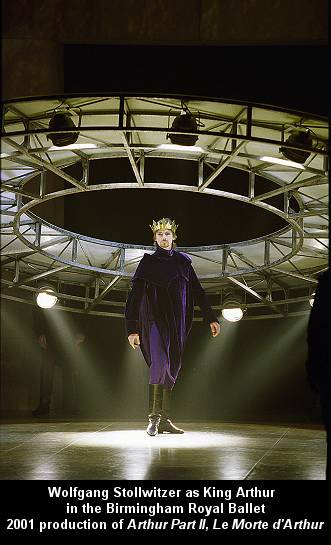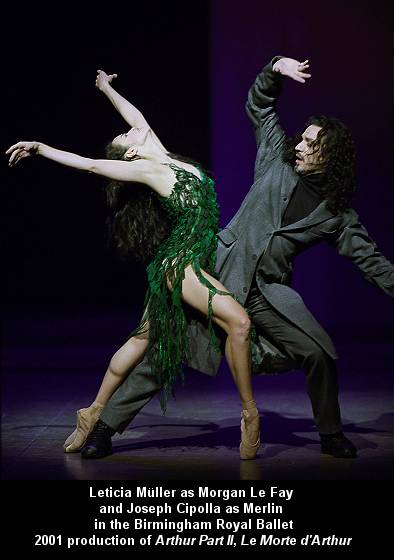|
<< -- 2 -- Roderic Dunnett A DEEPER PLANE

Certain aspects of the décor -- Peter Davison's sets and Jasper
Conran's red, black and velvety maroon-emphasing costumes -- invited enthusiasm,
but the sum of the parts felt marginally disappointing : less kitsch than
Part I, with an imposingly introduced round table and a slightly Stratfordesque
metallic scaffoldry background to the battle scenes. A clutch of braziers
burst into fire to illuminate, eerily, Morgan's malefactoring, with a nicely
thought out trompe d'oeuil with their reduction, later, to a single
brazier, placed rearstage, as an economical reprise.
Conran's most attractive conceit was the costuming of the Four Horsemen
of the Apocalypse, who appeared for two galvanising if not quite consequential
dances near the end, as the last battles -- somewhere between Götterdämmerung,
Weltkrieg and a Dürer Apocalypse -- rage. But it was Peter Mumford's
lighting (projections by John Driscoll) that most pleased the eye : a rather
too obvously pixel-like dappled effect for the enchanting courtly outdoor
dance, but some genuinely atmospheric brick-like interiors cast across the
beige beechwood-coloured set (which, in plain light, tended to make the
costumes look like curiously dowdy velvet).
Bintley's abstract creations can be wonderful; it is partly because of
a tendency to go for the obvious, and to the exaggerated milking of effect,
that his Arthur II narrative -- unlike his Edward II choreography,
which really did probe character -- still rather limps along.

There are exceptions : if Wolfgang Stollwitzer is stuck there as a disappointingly
leaden (presumably all to consciously impotent) Arthur, devoid of any presence,
compared with Robert Parker's lithe youngster of Part I, and Joseph Cipolla's
charismasless Merlin seems even more like a Rastafarian caretaker who has
accidentally lumbered onto the set, Bintley has nonetheless drawn on an
attractive young principal in Kosuke Yamamoto, whose death-dance as the
poisoned boy Gareth proved as bewitching as anything thitherto. There is
a lot of tenderness in the First Act Lancelot-Guinevere scene (Shannon a
visually peculiar Lancelot, though with a curious, Helpmannesque allure);
and Guinevere's Passacaglia-like solo was infused by moments of marked beauty.

Continue >>
Copyright © 27 May 2001
Roderic Dunnett, Coventry, UK
 VISIT THE JOHN McCABE WEBSITE
VISIT THE BIRMINGHAM ROYAL BALLET WEBSITE
READ THE STORY OF THE BINTLEY/McCABE COLLABORATION
READ RODERIC DUNNETT'S REVIEW OF 'ARTHUR PART I'
<< Music
& Vision home
Peter Breiner >>
VISIT THE JOHN McCABE WEBSITE
VISIT THE BIRMINGHAM ROYAL BALLET WEBSITE
READ THE STORY OF THE BINTLEY/McCABE COLLABORATION
READ RODERIC DUNNETT'S REVIEW OF 'ARTHUR PART I'
<< Music
& Vision home
Peter Breiner >>
|

